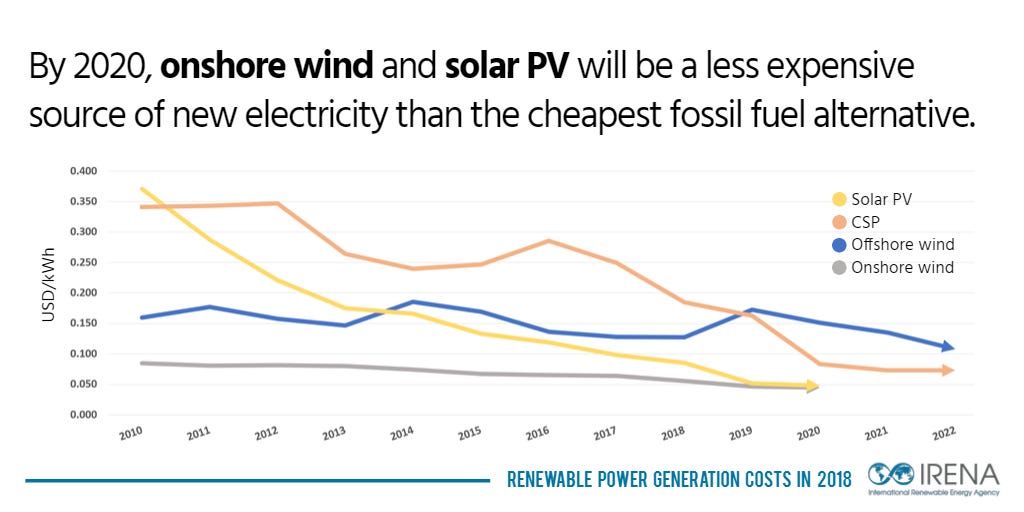#5: Scaling Solar Power
The price of solar power, unlike wind, has dropped significantly in the past decade and can now be as low as 6 cents / kWh of electricity, about half the national average cost of electricity.
We left off last time by rerouting 71% of the petroleum usage from transportation to electricity production. Now, let’s replace as much of that as we can with solar panels.
How much actual sun is there?
Let’s start with how much energy the sun outputs. There are a few things that hurt us here.
1. The tilt of the surface of the US is at an angle towards the sun, which reduces the intensity of the sun by 40% compared to the equator.
2. The sun only shines for about 35% of the day due to clouds
3. During the perfectly sunny days, the average intensity is only 32% compared to the intensity at noon.
Here is a Solar Insolation Maps that shows how many kWh of energy per square meter the sun delivers in different areas of the world on average.
How much of that can we capture?
The capacity factor of a solar panel measures how much of the actual energy from the sun can be captured. The theoretical limit is 45% but in practice, its more like 20%.
This means that for most of the US, we will be able to get about 0.7 kWh / square meter of panels.
Time to start installing some solar panels!
Remember, here’s where we are now:
We want to cut into the Petroleum -> Electricity production as much as possible with renewables to reduce carbon emissions. Let’s see how far we can get with solar panels.
Currently the US only produces 307 TWh / year. This is equal to about 840,000,000 kWh / day. If we assume 0.7 kWh / square meter, then we currently have about 460 square miles of solar panels installed across the US.
Rhode Island is 1,200 square miles, so this is equivalent to about 40% of the size of Rhode Island.
Bloomberg published a fascinating map that depicts how America uses its land. This will help us get a sense of the amount of area necessary for solar power.
How much land can we reasonably reserve for solar panel installation? Let’s start by installing the equivalent of the land we use for airports. Each of those little squares is equal to 0.25 million acres.
Airports use 3M acres of land. If we installed the solar panels of the equivalent size, that would bring 8,500,000,000 kWh / day of energy, or 3100 TWh / year.
Golf courses use about 2.5M acres of land. Installing solar panels over these would add an additional 2550 TWh / year.
The 5650 TWh solar generates per year is enough to completely offset the need for the petroleum we are using to generate electricity. This is about a 18x increase in the amount of solar we currently have installed.
Concentrated solar power
All the solar power we talked about above is captured using solar photovoltaic panels. There is a completely different way to capture solar energy, which doesn’t use photovoltaic cells, called concentrated solar power. This is essentially just mirrors that concentrate sunlight at a common point to produce heat energy. That heat is then used to convert water to steam, and spin a turbine.
Here is an image of one in practice:
CSP’s have the disadvantage that they are:
Less efficient
More complex to build and maintain
Require large amounts of land
More expensive
For all these reasons, they are quickly becoming an obsolete technology.
But the one thing they do better is being able to store large amounts of captured energy in the form of heated liquid in thermal storage tanks for as long as 16 hours. This allows CSP plants to capture sunlight during the day and release it at night. We might have to revisit this technology depending on where our investigations take us.
The lights went out again
The sunlight has the same variability problem as wind: What do you do when the sun is gone?
Here is an insolation map showing the amount of sun energy during June.
Compare that to the same map during winter.
In most areas, we lose about 50% of solar power during winter. In the energy system we built above, that’s about 10% of our total energy supply, at exactly the moment we need it most: for heating our homes!
In addition, solar power drops to 0 at night, which means that every night, 20% of our total energy supply disappears.
In Summary
Build solar panels equivalent to the size of all golf courses and all airports in the US is able to replace about half of our total petroleum usage.
But half of this solar supply disappears during winter, and all of it disappears at night.
Up Next…
Let’s start tackling this problem of intermittent energy by doing some back of the napkin math on how much energy we’ll have to store short term (daily), and annually (long term).
If this was interesting to you, and you want to stay in the loop, sign up for the newsletter:













